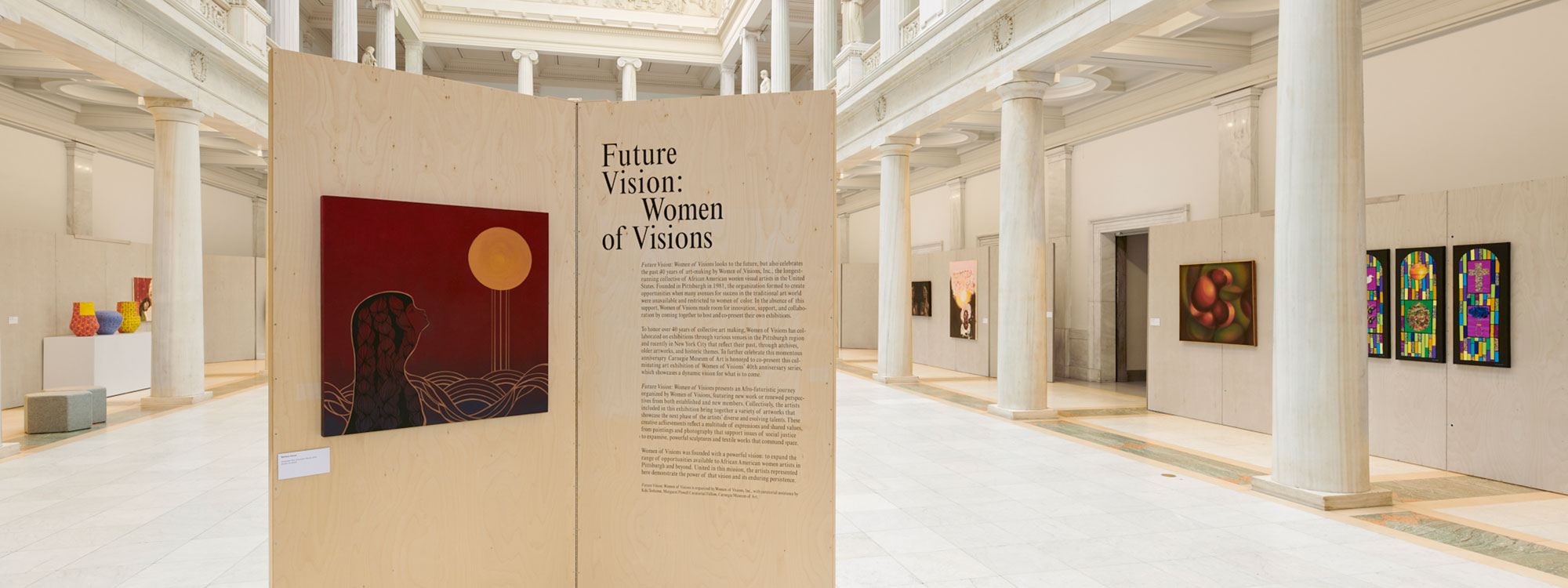You May Also Like
Visions for a Better World The Consummate Friend and Volunteer Creating Belonging Through ArtRell Rushin was amazed to see her own painting mounted in Carnegie Museum of Art. But the moment wasn’t just for her.
It revealed new possibilities for her family members who might feel unwelcome in many museum spaces.
“I think it’s important to show that, hey, this is something I do, and suddenly it becomes a possibility for them because they know it exists,” says Rushin, who is based in Pittsburgh’s East End.
On first glance, Rushin’s piece appears to be a celebration of Black hair culture. A deeper reading of her work points to representation, the future of Black women, and what it means to have a space to exist.
“Where can we go and exist without anti-Blackness, the idea of escapism, being allowed to be free from that pressure?” Rushin asks. “It’s really just imagining a world of being able to escape and exist and have all the things I need and be the person that I want to be.”
For decades, Rushin notes, opportunities for Black women to create and display their art in Pittsburgh have been limited.
In 1981, a collective of African American women based in Pittsburgh formed Women of Visions in response to having faced decades of erasure of their experience and artistic expressions from art institutions.
Future Vision: Women of Visions, an exhibition at Carnegie Museum of Art that featured more than 50 works by 22 artists, marked the collective’s 40th anniversary and a new chapter for the group. It was a first for Women of Visions and the museum.
“When you think about representations, particularly representations of Black women in this museum, it can only be described as an absence and as a gap,” says Amanda Awanjo, who facilitated the Women of Visions artist talk at the museum, adding that she was “shook to my core” strolling through the gallery admiring the artwork.
“It’s glaringly apparent that the museum cannot be whole, the archive cannot be whole, without exhibitions like Women of Visions,” Awanjo says.
The Women of Visions works displayed in the museum’s Hall of Sculpture featured the faces of mothers, grandmothers, and daughters etched on paper bags; sculptures of Black women adorned in beads and colorful patterns; paintings of abstracted Black faces with afros, thick lips, and braids.
“Black females are often not represented in the art world,” says Janet Watkins, a member of Women of Visions. “No one was interested in the type of work they thought we created. However, our members have created a wide range of art using every medium, from clay to watercolor.”
“It’s really just imagining a world of being able to escape and exist and have all the things I need and be the person that I want to be.” – Rell Rushin, Pittsburgh artist
“Forty years ago, when we reached out to the galleries and organizations for exhibits, we just didn’t get any type of response at all,” Watkins continues.
The exhibition captured the individuality of the artists and the power of the collective. It also showcased the depths and variations of the Black experience.
“The art and the artists both push the narrative that Black people are not a monolith,” says Kiki Teshome, who was the museum’s Margaret Powell Curatorial Fellow at the time.
As a child, Christine Bethea watched as her grandmother quilted square upon square of beautiful patterns until soon, “the quilt would start creeping up on me.”
She eventually developed her own penchant for collecting fabric scraps and other items left behind, finding ways to put them back together into a colorful quilted fusion that tells a new story and allows old pieces to live anew. Her art is that of the past—reused fabrics and items—and the future—sustainable, eco-friendly, and imaginative.
“It was important to me to use the old and the new,” says Bethea, the current president of Women of Visions, believed to be the oldest art collective for African American women in the U.S. “You’re weaving that history, story, those people, those times or places into your work.”
Bethea spent hours searching at flea markets, sorting through trash bins, and digging up more than 50 strips of fabrics over time to create African-American Kuba Cloth #57, her woven homage to Pittsburgh (and a reference to “Heinz 57”). To Bethea, all things can be reimagined.
The exhibition and anniversary celebration “actually insist on the presence and the rich cultural legacies of Black women artists in this region, and how they’ve been working nationally this whole time,” says Dana Bishop-Root, director of education and public programs at Carnegie Museum of Art.
“We want to think about who walks through the museum’s doors, what histories people are holding,” Bishop-Root says. “Being really explicit about listening to our neighbors, our communities throughout the region about who does and does not feel welcome in this museum, who has and has not felt seen and heard in this museum.”
Watkins says she never imagined her work would someday be featured at Carnegie Museum of Art.
Four years ago, she was saying goodbye to a banking career that spanned more than 30 years. Soon after, she stumbled upon a church offering pottery classes. It wasn’t long before she fell in love with clay. Her clay works were also featured in the exhibition.
“To this day, I’m looking at photos and information from the exhibit, still convincing myself it wasn’t just a dream; it actually happened,” Watkins says. “I think most would agree you don’t typically expect to see my race, gender, or age range represented at the Carnegie.”
Receive more stories in your email
Sign upTags:
Art
